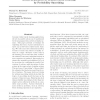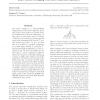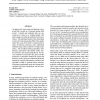90
Voted
ICML
2002
IEEE
16 years 1 months ago
2002
IEEE
We empirically evaluate several state-of-theart methods for constructing ensembles of heterogeneous classifiers with stacking and show that they perform (at best) comparably to se...
94
Voted
ICML
2002
IEEE
16 years 1 months ago
2002
IEEE
In many reinforcement learning applications, the set of possible actions can be partitioned by the programmer into subsets of similar actions. This paper presents a technique for ...
85
Voted
ICML
2002
IEEE
16 years 1 months ago
2002
IEEE
The naive classifier is a well-established mathematical model whose simplicity, speed and accuracy have made it a popular choice for classification in AI and engineering. In this ...
ICML
2002
IEEE
16 years 1 months ago
2002
IEEE
Classification of email is an important everyday task for a large and growing number of users. This paper describes the machine learning approaches underlying the i-ems (Intellige...
105
Voted
ICML
2002
IEEE
16 years 1 months ago
2002
IEEE
We propose a new statistical approach to extracting personal names from a corpus. One of the key points of our approach is that it can both automatically learn the characteristics...
76
Voted
ICML
2002
IEEE
16 years 1 months ago
2002
IEEE
ICML
2002
IEEE
16 years 1 months ago
2002
IEEE
118
Voted
ICML
2003
IEEE
16 years 1 months ago
2003
IEEE
Convex programming involves a convex set F Rn and a convex cost function c : F R. The goal of convex programming is to find a point in F which minimizes c. In online convex prog...
89
Voted
ICML
2003
IEEE
16 years 1 months ago
2003
IEEE
167
Voted
ICML
2003
IEEE
16 years 1 months ago
2003
IEEE
An approach to semi-supervised learning is proposed that is based on a Gaussian random field model. Labeled and unlabeled data are represented as vertices in a weighted graph, wit...



